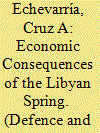| Srl | Item |
| 1 |
ID:
167863


|
|
|
|
|
| Summary/Abstract |
In 2011 a wave of revolutionary movements, the so-called Arab Spring, spread in the Middle East and North Africa. Libya was one of the most affected countries, ending Gaddafi’s dictatorship after an international intervention and a civil war. This paper assesses the effects that this revolution had on Libyan economy. The analysis is made by means of the synthetic control method. Our estimates for the 2011–2014 period show (i) a cumulative loss in the growth rate of per capita real GDP of 64.15%; (ii) a cumulative loss in per capita real GDP of 56,548 dollars; and (iii) a cumulative loss in the aggregate real GDP of 350.5 billion dollars.
|
|
|
|
|
|
|
|
|
|
|
|
|
|
|
|
| 2 |
ID:
184051


|
|
|
|
|
| Summary/Abstract |
This study estimates the joint effect of a new political regime and war against Iraq, on Iran’s per capita Gross Domestic Product (‘GDP,’ constant 2010 US$) for the period 1978–1988, during the revolution/war. I use a synthetic control approach, whereby a synthetic Iran is constructed as a weighted average of other Middle East and North Africa (‘MENA’)/Organization of the Petroleum Exporting (‘OPEC’) countries to match the average level of some key per capita GDP correlates over the period 1970–1977 as well as the evolution of the actual Iranian per capita GDP during that period. I find a sizable negative effect of the joint treatment. The average Iranian lost an accumulated sum of approximately US$ 34,660 during 1978–1988 (i.e. the average annual real per capita income loss of US$ 3,150). This loss equals 40% of the real income per capita, which an Iranian could earn in the absence of revolution and war. The confidence sets based on constant, linear, and uniform assumptions of treatment effect show that estimated income loss for Iran is sizeable and statistically significant. The results remain robust to a set of placebo tests.
|
|
|
|
|
|
|
|
|
|
|
|
|
|
|
|
| 3 |
ID:
161861


|
|
|
|
|
| Summary/Abstract |
This paper studies the wage penalty of overeducation using the World Bank's STEP (Skills Towards Employability and Productivity) survey in China. Based on the measurements of cognitive, technical, and non-cognitive skills, the overeducated have systematically lower abilities compared with the well-matched, just as the skill heterogeneity theory predicts. Endogenous switching model is adopted to estimate the effect of overeducation on wage. We find that the overeducated workers with tertiary education suffer from significant loss compared with the well-matched workers, while overeducation has no significant effect on workers with high school education. The causality inference using nearest neighbor matching and propensity score weighted regression methods reveals that our conclusions are robust.
|
|
|
|
|
|
|
|
|
|
|
|
|
|
|
|